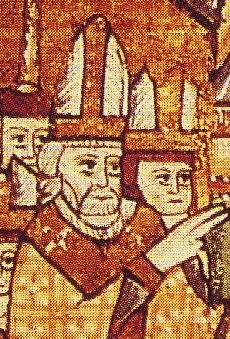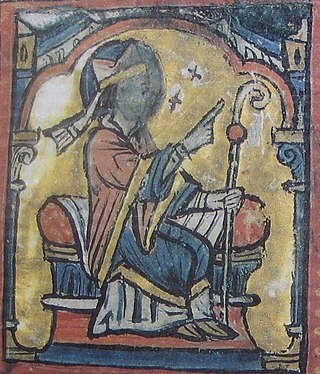Related Research Articles

Bruno di Segni was an Italian Roman Catholic prelate and professed member from the Order of Saint Benedict who served as Bishop of Segni and Abbot of Montecassino. He studied under the Benedictines in Bologna before being appointed a canon of the cathedral chapter of Siena. He was invited to Rome where he became a bishop and counselled four consecutive popes. He served as Abbot of Montecassino but when he criticised Pope Paschal II regarding the Concordat of Ponte Mammolo in 1111 the pope relieved him of his duties as abbot and ordered Bruno to return to his diocese, where he died just over a decade later. Bruno's canonization was celebrated on 5 September 1181 under Pope Lucius III who presided over the celebration in the late bishop's diocese.

Henry of Marcy, or Henri de Marsiac, was a Cistercian abbot, first of Hautecombe in Savoy (1160–1177), and then of Clairvaux, from 1177 until 1179. He was created Cardinal Bishop of Albano by Pope Alexander III at the Third Lateran Council in 1179.

Albinus was an Italian Cardinal of the late twelfth century. A native of Milan, or perhaps of Gaeta, he became an Augustinian regular canon.

The 1088 papal election subsequent to the death of Pope Victor III in 1087 was held on 12 March 1088. Six cardinal-bishops, assisted by two lower-ranking cardinals, elected Cardinal-Bishop of Ostia Odon de Lagery as the new Pope. He assumed the name Urban II.
The October 1187 papal election was convoked after the death of Pope Urban III. He and the papal court had escaped from the imperial blockade of Verona only the month before, and had taken refuge in Ferrara. The election, held in Ferrara the day after the pope's death, resulted in the election of Cardinal Alberto Sartori di Morra, who took the name of Gregory VIII. He was a partisan of the Emperor Frederick Barbarossa, whose election delighted him. Gregory VIII reigned only two months.

The December 1187 papal election was convoked after the death of Pope Gregory VIII. It resulted in the election of Cardinal Paolo Scolari, who took the name of Clement III.
Ottaviano di Poli, a member of the family of the Counts of Poli, was an Italian Roman Catholic Cardinal.
Oderisio di Sangro was an Italian Benedictine monk and cardinal, the son of Count Rinaldo of the family of the conti di Sangro in the Marsi.

The 1191 papal election took place after the death of Pope Clement III. Pope Clement, according to differing and irreconcilable reports, died in March 1191, in the last third of the month, on the 20th, the 25th, the 26th, the 28th, or perhaps 2 April or 4 April, or 10 April. The election was conducted during the march of King Henry VI and his army toward Rome. The 85-year-old Cardinal Giacinto Bobone, a member of the Orsini family, was chosen after some extreme reluctance. He took the name Celestine III. Pressed by the Romans, however, he agreed to negotiate with King Henry about his coronation as emperor and about the possession of the city of Tusculum. Celestine postponed his own consecration in order to buy time to negotiate. He was finally crowned on Easter Sunday, 14 April 1191.

Pietro Diani was an Italian cardinal. The name "Diana" is incorrect; he signs himself Petrus Dianus.
Petrus Pisanus was a Roman Catholic Cardinal. He began his career in papal service as a scriptor in the chancellery. He was appointed Deacon of San Giorgio in Velabro, and then promoted Cardinal-priest of Santa Susanna. He served briefly as papal legate in Corsica, before becoming a permanent member of the papal court. He participated in the papal elections of 1118, 1124, and 1130. In 1130, he chose to support the Obedience of Anacletus II rather than that of Innocent II. After Anacletus died in 1138, he joined the Obedience of Innocent II, and survived the purge of 1139.

Laborans de Pontormo was an Italian cardinal. His name in Italian is Laborante. He was a native of Pontormo, a suburb of the city of Florence on the left bank of the Arno River. He was a distinguished jurist and influential writer on canon law.

Radulfus Nigellus was a cardinal of the Roman Catholic Church. He was a native of Pisa, or perhaps of France.

Rolandus was a cardinal of the Roman Catholic Church. He was a native of Pisa, not Siena or Brittany. He was elected archbishop of Dol, but was not consecrated for five years, due to the opposition his metropolitan, the archbishop of Tours. Before he became a cardinal, he was sent by Pope Lucius III as his representative to Scotland to attempt to resolve a dispute over episcopal elections, involving the king.

Bobo was a cardinal of the Roman Catholic Church. He was a native of Rome, and a member of the Bobone family, later called the Orsini.

Graziano da Pisa was a cardinal of the Roman Catholic Church. He was a native of Pisa, and the nephew of Pope Eugenius III (1145-1153). He had studied law in Bologna, and held the rank of Magister. He was a prominent official in the papal chancery, and an accomplished papal diplomat.

Ardicio de Rivoltela was a cardinal of the Roman Catholic Church. He was a native of Piadena (Platina), in the diocese of Cremona in Lombardy. The appellation "de Rivoltela" is mentioned only once, and its significance is unclear.
Theodinus, O.S.B. was a Benedictine monk, and a cardinal of the Roman Catholic Church. He was a native of Arrone, a hilltop town 15 km east of Terni. He became a cardinal priest, and then cardinal bishop of Porto. He served as a papal diplomat, in Normandy, in the Balkans, and in Venice. He participated in the papal elections of 1181 and 1185.

Pietro de Bono was a cardinal of the Roman Catholic Church. He was a native of Verona in Lombardy, signing his name at least once as D. Petri de Verona. He was not from Pisa, nor was he from Bologna. He belonged to the Canons Regular of S. Maria di Reno in Bologna.
Joannes Anagninus was a cardinal of the Roman Catholic Church. He was a native of Anagni, and belonged to the family of the Counts of Anagni, the same family which produced Pope Innocent III. His colleagues called him, and he called himself "Joannes Anagninus". In 1191, he subscribed himself Joannes comes Anagninus, episcopus cardinalis Praenestinus. He was successively cardinal deacon of S. Maria in Portico, cardinal priest of S. Marco, and cardinal bishop of Palestrina.
References
- ↑ Kartusch, p. 41. Ganzer, p. 148. Early authors report that he was French, "Gallus".
- ↑ Monaco, "Migliore.", speculates that the degree might have been in canon law.
- ↑ Stephen of Tournai, Epistolae LXXXIII, in: J.P, Migne (ed.), Patrologiae Latinae Cursus Completus Tomus CCXI (Paris 1855), p. 379. The editor remarks, note 36: "Forsan non aberrabo si hunc Meliorem archidiaconum, eum esse dixerim qui postea S. R. E. cardinalis creatus est, ad quem epist. 113, cum praesertim addat in proximo melioris fortunae futurum, subintelligens cardinalitiam dignitatem, ad quam vocabatur, ut valde est probabile." This would apparently date the letter just before 1184.
- ↑ Ferdinand Gregorovius, (1896), The History of Rome in the Middle Ages Vol. IV, part 2. (London: George Bell 1896), pp. 609-611. Jaffé II, pp. 465-466.
- ↑ Gregorovius, p. 611.
- ↑ Ganzer, p. 148, note 4. Robert de Monte, "Cronica", at 1184, in: Monumenta Germaniae Historica Scriptorum Tomus VI (Hannover: Hahn 1844), p. 534" "Lucius papa in capite ieiunii, id est feria 4 cinerum, ordinavit plures cardinales, inter quos Magistrum Meliorem presbiterum cardinalem, quem etiam fecit camerarium suum.. Ciaconius-Olduin I, p. 1118, also consider the date 1185.
- ↑ Jaffé, #15471.
- ↑ Ralph of Diceto, in: J. Watterich, Pontificum Romanorum... Vitae, p. 663. Horace Kinder Mann, The Lives of the Popes in the Early Middle Ages, Volume 10 (London: Kegan Paul 1914), pp. 286-289.
- ↑ F. Gregorovius, The History of Rome in the Middle Ages Vol. IV, part 2 (London: George Bell 1896), pp. 610-612.
- ↑ Jaffé II, p. 494, nos. 15486 and 15487. J.P. Migne (ed.), Patrologiae Latinae Cursus Completus Tomus CCII (Paris 1855), pp. 1337, 1341.
- ↑ Jaffé II, p. 527, no. 16010. J.P. Migne (ed.), Tomus CCII, p. 1532.
- ↑ Jaffé, pp. 527-528. Gregorovius, p. 614.
- ↑ J. von Pflugk-Harttung, Acta pontificum Romanorum inedita III (Stuttgart: W. Kohlhammer 1886), p. 346.
- ↑ Ganzer, p. 148. Monumenta Germaniae Historica. Legum sectio IV. Constitutiones et acta publica imperatorum ac regum Tomus I (Hannover: Hahn 1893), p. 477, no. 333.
- ↑ Ganzer, p. 148. F. Ughelli, Italia sacra Vol. III (Venice: Coleti 1718), p. 712. Cappelletti, Le chiese d'Italia Vol. XVII, pp. 694-695. P. Gams, Series episcoporum ecclesiae catholicae (Ratisbon: Manz 1873), p. 756 column 1.
- ↑ Monaco, "Migliore.", § 3: "nel 1191 divenne vescovo di Massa Marittima, per essere poi designato durante il pontificato di Celestino III legato a latere per la Francia, carica che rivestì dal 1193 al 1197." There is no evidence of a resignation (and becoming a legate does not require a resignation); being a bishop would be a positive status for a legate.
- ↑ Ganzer, p. 149: "Auf jeden Fall aber gab Melior das Bistum wieder auf." There is no evidence for such a claim.
- ↑ Alfred Haverkamp (1970), Herrschaftsformen der Frühstaufer in Reichsitalien, Tom 2 (Stuttgart: Hiersemann 1970), p. 473, citing: Gisela Lüpke (1962), Die Aeugen in den Urkunden Heinrichs VI (Wien: Institut für österreichische Geschichtsforschung).
- ↑ J.P. Migne (ed.), Patrologiae Latinae Cursus Completus Tomus CCVI (Paris 1855), p. 906.
- ↑ J.P. Migne (ed.), Patrologiae Latinae Cursus Completus Tomus CCVI (Paris 1855), p. 994, 998, 1103, 1106.
- ↑ Roger of Hoveden, "Chronica", in: William Stubbs (ed.), Chronica Magistri Rogeri de Houdene Vol. III (London: Longman and Trübner 1870), p. 228.
- ↑ Migne, Patrologiae Latinae Cursus Completus Tomus CCXI, p. 399.
- ↑ Robert Davidsohn, Philipp II. August von Frankreich und Ingeborg(in German) (Stuttgart: Kröner 1888), pp. 32-34.
- ↑ Davidsohn, pp. 39-46.
- ↑ Celestine had received an accurate genealogy from King Canute, perhaps in August 1194. Davidsohn, pp. 53-54.
- ↑ He is identified as the Prior of S. Prassede: Davidsohn, p. 58. M.J.J. Brial (ed.), Recueil des historiens des Gaules et de la France, Volume 19 (Paris: Imprimerie royal 1833), p. 319.
- ↑ Jaffé II, p. 614, no. 17241.
- ↑ "...intuitu Dei, ad preces cardinalis et abbatis Cisterciensis....," in: Roger of Hoveden, "Chronica", pp. 257, 259. Stubbs identifies the cardinal as Melior, cardinal priest of S. John and S. Paul, and the abbot of Cîteux as Guy Paré.
- ↑ "...ab Illustri Rege Danorum Romam transmissi, ejusdem Regis domini nostri negotium auribis summi Pontificis diligenter intulimus.... Est autem domini Regis negotium inter Regem et Reginam celebratum divortium."
- ↑ M.J.J. Brial (ed.), Recueil des historiens des Gaules et de la France, Volume 19 (Paris: Imprimerie royal 1833), pp. 317-318.
- ↑ Davidsohn, pp. 62-63. Brial (ed.), Recueil des historiens des Gaules et de la France, Volume 19, pp. 319-320. J.D. Mansi (ed.), Sacrorum Conciliorum nova et amplissima collectio, edito novissima, Tomus XXII (Venice: A. Zatta 1778), p. 672.
- ↑ Davidsohn, pp. 63-64.
- ↑ P. Kehr, "Papsturkunden in Friaul.," Nachrichten von der Königlichen Gesellschaft der Wissenschafter zu Göttingen, philologisch-historische Klasse(in German) (Berlin: Weidmann 1899), p. 282, no. 24. Migne (ed.), Tomus CCVI, p. 1141.
- ↑ Daniel Berger, Klaus Herbers &Thorsten Schlauwitz (ed.): Papsturkunden in Spanien. Vorarbeiten zur Hispania (Iberia) Pontificia. III. Kastilien, De Gruyter Akademie Forschung 2020, p. 521-525 no. 287